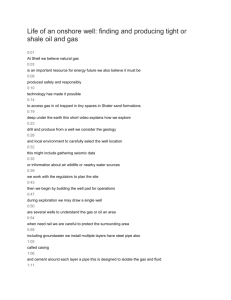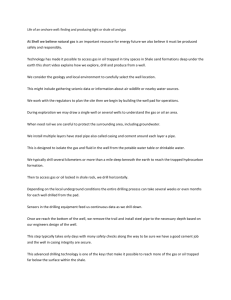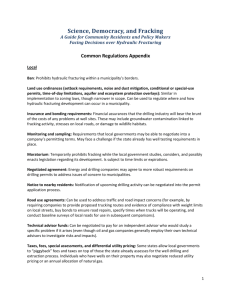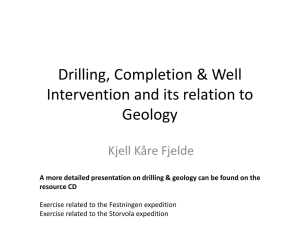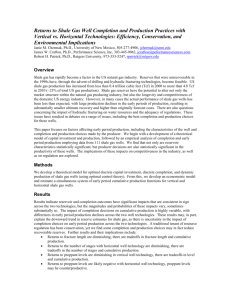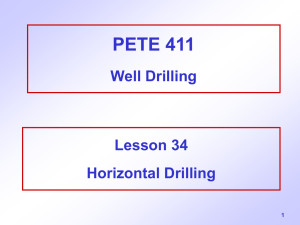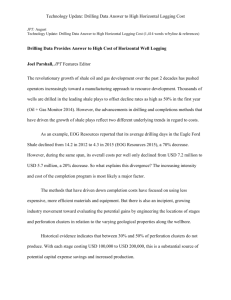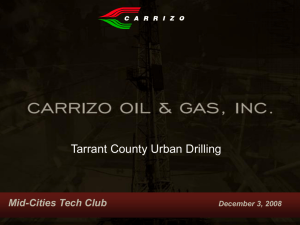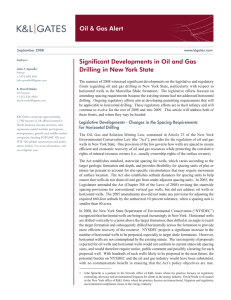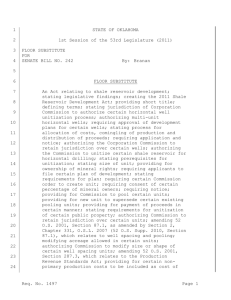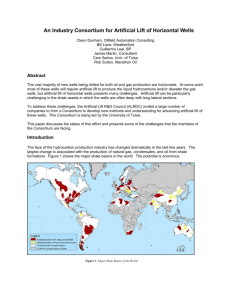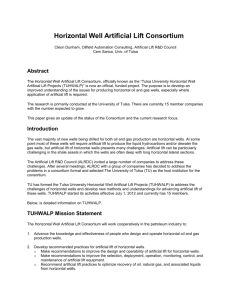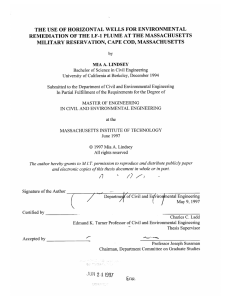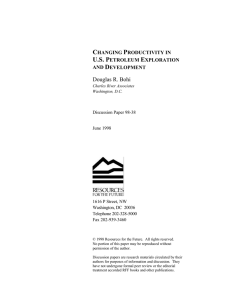File
advertisement
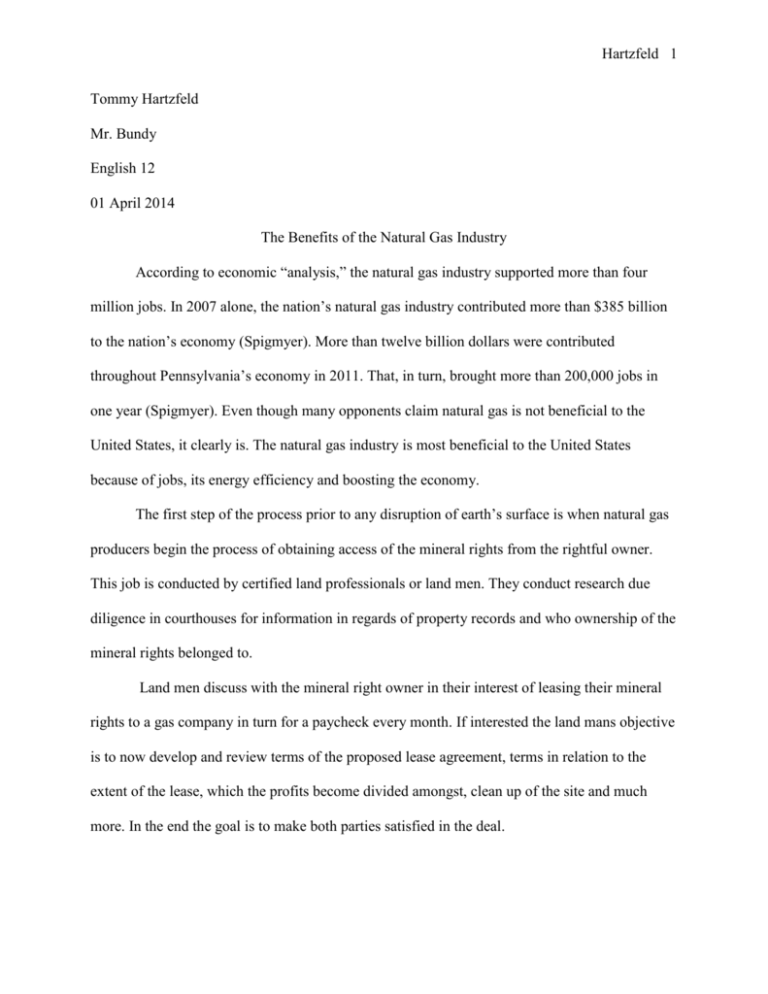
Hartzfeld 1 Tommy Hartzfeld Mr. Bundy English 12 01 April 2014 The Benefits of the Natural Gas Industry According to economic “analysis,” the natural gas industry supported more than four million jobs. In 2007 alone, the nation’s natural gas industry contributed more than $385 billion to the nation’s economy (Spigmyer). More than twelve billion dollars were contributed throughout Pennsylvania’s economy in 2011. That, in turn, brought more than 200,000 jobs in one year (Spigmyer). Even though many opponents claim natural gas is not beneficial to the United States, it clearly is. The natural gas industry is most beneficial to the United States because of jobs, its energy efficiency and boosting the economy. The first step of the process prior to any disruption of earth’s surface is when natural gas producers begin the process of obtaining access of the mineral rights from the rightful owner. This job is conducted by certified land professionals or land men. They conduct research due diligence in courthouses for information in regards of property records and who ownership of the mineral rights belonged to. Land men discuss with the mineral right owner in their interest of leasing their mineral rights to a gas company in turn for a paycheck every month. If interested the land mans objective is to now develop and review terms of the proposed lease agreement, terms in relation to the extent of the lease, which the profits become divided amongst, clean up of the site and much more. In the end the goal is to make both parties satisfied in the deal. Hartzfeld 2 The next key step of the process in exploration of natural gas is a specific geological condition, beneath the ground. Geophysicists use both two dimensional and three dimensional seismic testing. How this works is a seismic truck is used to go upon the ground subject to exploration. The truck is used to drill into the earth’s surface approximately twenty feet then insert a seismic charge. When detonated the charge sends waves into subsurface rock formations. The evenly distributed waves then reflect off the formations in return for the surface. Waves are received and interpreted by geophones that are placed at the top of each of the seismic holes. The vibrations are translated then into signals that can be electronically logged for use in geological studies. The information from the tests increases the probability for more accurate placement of a drilling location. Three dimensional drilling includes more electronically logged data, advanced technology and more sensitive geophones, and a grid at which they are better placed. By controlling at which the rate the charges ignite. This enables geophysicists to interpret the different thickness of the formations of earth’s strata. Determining the specific formations and there lengths rather than just the general depth regions. When seismic tests come back with positive results, the stages of drilling begin. With 21st century technology we are enabled to drill vertical and horizontal. Vertical wells or shallow wells are the more common of the two. A vertical well will not travel a quarter of the distance of a horizontal well and they require a fraction of the cost. Vertical wells are good to gather valuable information in determining whether it would be a point of interest for a horizontal well. Horizontal wells are bigger in every way except the amount disturbed surface area. When it is all said and done with horizontal technology, there is only one whole left in the ground. Hartzfeld 3 With a horizontal well the amount of ground that would be explored beneath the earth’s surface can be an equivalent to having five or six vertical wells. The drilling process begins with what is called the well casing process. In efforts to ensure the long term integrity of the well and to protect and preserve underground water, a conductor bit over two feet in diameter drills below the identified freshwater aquifers. A pipe is centered in the conductor hole and cement is pumped down the pipe, coming out the bottom of the pipe and filling the “annular “space between the inside of the hole and the pipe. This in turn forms a lining of the well to keep fresh water zones separate from all stages of production. After the well has been lined with cement a specific charge is placed into the well lined with cement. When detonated it then perforates and cracks the cement. A Hydraulic fracturing truck then at high pressure pumps water into the well. The high pressured water takes the path of least resistance through the cracks in the cement at high pressures into the shale formations. The hydraulic fracturing fluid is made up of about 95% sand and water (Spigmyer). That creates opportunity for microscopic fissures in formations of shale gas to be formed. Those fissures are what allow the flow of hydrocarbons from the rock formation into a well bore. It creates pressure on any trapped pockets of gas and releases them. To put into perspective the fracturing of a horizontal well requires anywhere from three to five million gallons of water. Imagine three to five Olympic swimming pools pressured down a hole in the ground less than two feet in diameter. That water is not just being pumped into a hole, its being reused. In some cases producers, are recycling up to 100% of the water that they pumped down the well. Hartzfeld 4 Once the well is done being fractured, it is plugged in hold for production. A gas company will then run a gathering pipe line to the well. This gathering line is used to transport the gas to a transmission pipeline. A transmission line is where all domestically produced natural gas controlled. They calculate the rate at which how many cubic feet of gas are produced from a well in one day. Then the gas company reviews the terms of a lease that were created and agreed on between the land owner and the land man. A good land man is one where when this stage of the process, both parties the land owner and the gas company are both satisfied. Landowners get paid a percentage of the wells production. They get paid based on how much natural gas travels through their gathering line into the transmission line. So in turn, the natural gas from your well could be powering cars and heating houses around you. That is another boost to the local economy as a result of developing natural gas. Natural gas is the leading employer of the energy industry. 2007 “studies” show that they estimate there to be approximately 1500 trillion cubic feet of natural gas (Spigmyer). This gas is located beneath the lower forty-eight states. Advances in technology continue to make this number rise. Great contributors of an estimate to how much natural gas the nation holds are natural the gas reserves. These reserves are located in states like Texas, Oklahoma, Louisiana, Arkansas, Colorado, Kansas’s, Wyoming and Mississippi. Undoubtedly, the benefits of the natural gas industry outweigh the disadvantages. If the United States continues taking advantage of this industry, they could create better jobs, improve the economy, and create an energy efficient environment. Hartzfeld 5 Works Cited Spigelmyer, David J. “Marcellus Shale Coalition.” Marcellus Shale Coalition. David J. Spigelmyer, 2008. Web. 10 Mar. 2014. <http://marcelluscoalition.org/>.
